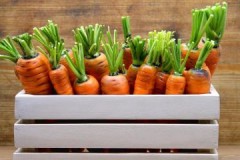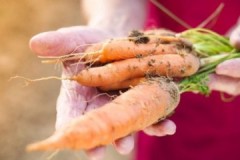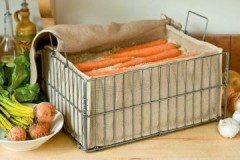Important rules for storing carrots and beets in the cellar for the winter
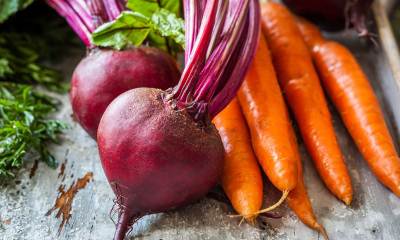 The harvested harvest of carrots and beets can be saved not only until the winter cold, but also until next autumn. A cellar is ideal for overwintering vegetables.
The harvested harvest of carrots and beets can be saved not only until the winter cold, but also until next autumn. A cellar is ideal for overwintering vegetables.
There are several ways to store root vegetables. Subject to certain rules, agricultural products can be stored both jointly and separately.
Let's analyze in more detail, how to properly preserve carrots and beets for the winter in a cellar, basement or basement.
Content
Can it be stored together?
Orange and burgundy root crops have similar requirements for laying for the winter. They match the required level of temperature and humidity. Harvesting of these crops also falls on the same period.
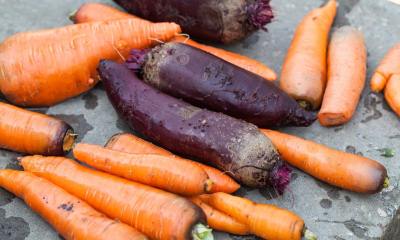 Both types of vegetables winter well in:
Both types of vegetables winter well in:
- sand,
- sawdust,
- clay,
- onion peel,
- peat.
This allows you to leave carrots and beets in the same cellar until spring, even in the same container.
With such similar features, root crops have some differences. Beets are considered to be a more mature crop, while carrots are considered more capricious.
That's why ideally these vegetables are kept separately... If this is not possible, then placing them in one box, it is necessary to separate the cultures with a layer of filler.
Stacking carrots and beets close to each other is not recommended. At the same time, being together in one cellar does not affect the quality of both vegetables.
Preparing for storage in the underground or basement
After digging from the ground, the roots must be fully prepared for storage in the underground. Ignoring this stage is fraught with rapid spoilage of plant products.
The preparatory process consists of sequential steps:
- The dug vegetables are dried in the fresh air in the shade.
- Remove dirt from the surface with a dry mitt or rag.
- Calibrate root crops, removing damaged and diseased ones.
- The tops of carrots and beets are cut to a height of 5-10 mm.
- The cut is powdered with chalk powder or ash.
Read about how to prepare carrots for long-term storage. here.
How is it correct, under what conditions?
 Regardless of the method of laying the crop, it is necessary to adhere to some general rules. Air temperature must remain stable throughout the months.
Regardless of the method of laying the crop, it is necessary to adhere to some general rules. Air temperature must remain stable throughout the months.
Its range can vary in a narrow limit: from 0 to +4 degrees. A lower temperature will cause the vegetables to freeze, while a higher temperature will sprout.
In both cases, the product deteriorates. In addition, the cellar is made ventilated and darkened. The air humidity in the room where the root crops are located should be 85-95%.
In sawdust
For storing carrots and beets suitable sawdust and wood shavings:
- ate,
- pine trees,
- fir.
Such material perfectly regulates humidity and serves as a thermal insulation layer.
A layer of sawdust 2-3 cm thick is poured into prepared containers. Vegetables are placed vertically on a loose "pillow" with their wide end down close to each other. Sprinkle wood filler on top so that it covers the tops of the carrots.
In sand
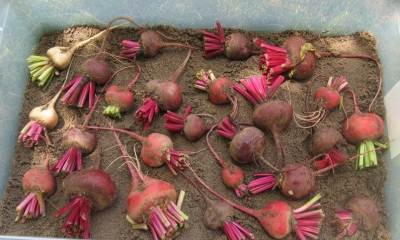 Sandy filler is disinfected by heating over an open fire or in the oven... Another way of disinfection is to soak the sand with a strong solution of potassium permanganate. But after such a procedure, the substrate should dry well.
Sandy filler is disinfected by heating over an open fire or in the oven... Another way of disinfection is to soak the sand with a strong solution of potassium permanganate. But after such a procedure, the substrate should dry well.
To prevent product rotting, chalk is added to the sand. A layer of sand is poured into the boxes and one type of root crop is placed. Cover vegetables with filler so that they cannot be seen.
Lay the second row of carrots or beets. They are again covered with sand. For beets, the sand is slightly moistened.
Containers are placed on racks or on the floor... In the latter case, the boxes must be on a wire rack or stand. In the sand in a cellar, vegetables retain their quality for up to 6-8 months.
In onion skins
Dry onion wrap removes excess moisture and protects agricultural products from fungal infection. The husk is poured into a box or bag.
Root crops are laid in such a way that each instance is surrounded by filler. The containers are covered with a lid, and the bags are tied with rope and sent to the cellar.
In the ground
High-moor peat is used as an earthen filler.... It should be a loose, poorly decomposed substrate. It is dried and the humidity level is brought to 40-50%.
A few more ways to store carrots in the ground are considered in this article.
In a plastic bag
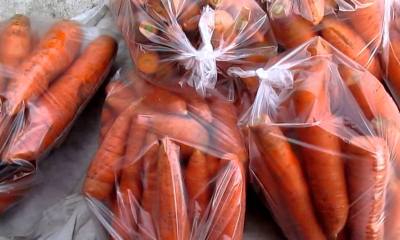 Large polypropylene or polyethylene bags are suitable for storage. Vegetables are placed in bags, then sealed or tied tightly.
Large polypropylene or polyethylene bags are suitable for storage. Vegetables are placed in bags, then sealed or tied tightly.
Polypropylene bags are semi-permeable, so they allow air to pass through... Polyethylene bags do not have this feature, so they are pierced with a thick needle in several places.
The bags are stacked on prepared racks or hung on a hook in the cellar. You can learn how to store carrots in bags here.
In clay
Before laying root crops, it is necessary to prepare a clay substrate... To do this, it is moistened with water for several days. Clay saturated with moisture acquires a creamy consistency.
The wooden box is lined with foil or polyethylene. If an enamel or plastic container is used for storage, a waterproof layer is not needed.
Next, root vegetables are placed in a container in one layer and poured with a chatterbox... After lightly "setting" the clay, lay out a layer of carrots or beets again and watered with clay filler.
Possible problems and how to solve them
During the storage period, problems may appear that affect the quality and shelf life of products. The most important ones are associated with changes in temperature, humidity, and the appearance of a fungus.
Each problem has its own solutions.
-
 Temperature change... With poor thermal insulation of the cellar, a decrease or increase in temperature is possible during the winter months.
Temperature change... With poor thermal insulation of the cellar, a decrease or increase in temperature is possible during the winter months.If the thermometer shows a critical mark below zero degrees, a bucket of embers can help out. If the temperature rises, the cellar should be ventilated.
- Humidity change... You can adjust this figure with salt and charcoal. The moisture-absorbing filler is poured into boxes and placed in the corners of the room.
- Mold growth... Lime is used to disinfect the cellar. It kills pathogenic fungi and simultaneously dries the air.
To reduce fungal infection of root crops, it is helpful to use plants that produce phytoncides. To do this, carrots and beets are shifted with branches of fern, mountain ash, tansy.
Tips and bans
So that the crop does not spoil, some nuances must be taken into account... They relate to harvesting, creating conditions in the cellar, properly preparing the store and vegetables.
Experts recommend postponing mid- and late-ripening varieties for long-term storage:
| Variety / Vegetable | Carrot | Beet |
| Late ripening | Autumn Queen, Red Giant, Vita Longa, Emperor | Renova, Gribovskaya, Incomparable, Egyptian flat |
| Mid-season | Nantes-4, Samson, F1 Nectar, Moscow winter | Bohemia, Cylinder, Opolska, Patrick |
Another factor that affects the preservation of vegetables is the harvest time. The most optimal way to dig up roots is in late September - early October.
A guideline for a successful harvest period can be 2-3 yellowed lower leaves in the tops. For cleaning, be sure to choose a dry day.
There are several taboos to keep in mind when storing and storing carrots and beets underground. In particular, it is strongly discouraged:
 Harvest in rainy weather.
Harvest in rainy weather.- Wash vegetables before placing them in the container.
- Fold undried roots.
- Leave rotten specimens in the cellar.
- Keep the temperature above +5 degrees in storage.
- Keep root crops in the same room and apples.
Related videos
A super-way of storing carrots and beets is presented in the video:
Conclusion
Carrots and beets retain their quality perfectly when stored in an unheated cellar. To extend the shelf life of products up to 12 months, it is recommended to follow all the rules.
To do this, you should choose mid- and late-ripening varieties, carefully prepare the cellar, filler, the product itself, and follow the technology of the chosen laying method.

